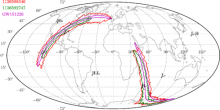
Abstract
Hardware injections are simulated gravitational-wave signals added to the Laser Interferometer Gravitational-wave Observatory (LIGO). The detectors' test masses are physically displaced by an actuator in order to simulate the effects of a gravitational wave. The simulated signal initiates a control-system response which mimics that of a true gravitational wave. This provides an end-to-end test of LIGO's ability to observe gravitational waves. The gravitational-wave analyses used to detect and characterize signals are exercised with hardware injections. By looking for discrepancies between the injected and recovered signals, we are able to characterize the performance of analyses and the coupling of instrumental subsystems to the detectors' output channels. This paper describes the hardware injection system and the recovery of injected signals representing binary black hole mergers, a stochastic gravitational wave background, spinning neutron stars, and sine-Gaussians.